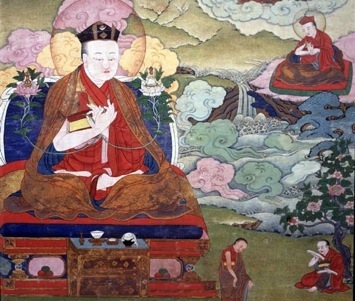mahamudra

the third karmapa, jetsun rangjung dorje
just finished an event with lama lhundrup and lama djangchub, from dagpo kagyu mandala in the auvergne.
i know lhundrup from the european buddhist union, enjoy his company, and been very interested in the experience of his community.
in particular i've been impressed by their three year retreats. at the minute they have something like 80 men and women, mostly between the ages of 25-35 on three year retreat, training in a full, traditional introduction to vajrayana practice in the kagyu tradition. i've been interested in what we can learn from this, both the practicalities of longer retreats, and the possibilities of way of training in meditation and the dharma.
lhundrup and djangchub spent a week at madhyamaloka with a small group of us, including manjuvajra and kulaprabha, who have a specialist responsibility for retreats: vessantara and prakasha who are involved in meditation teaching; scholars like saramati and sagaramati; and ratnadharini, parami and me, with responsibilities for ordination training.
the week was structured around lhundrup presenting a short text, The Path of Aspiration of the Mahamudra of Definite Meaning, by the third Karmapa, which let us understand in more depth their approach to meditation, and something of how they would present it in the context of their retreats.
most of the interbuddhist dialogue that i'm involved in tends to be organisational, and it is very satisfying to be able to have an exchange about things of central spiritual significance. lhundrup spends nine months of his year on retreat overseeing the three year trainings, and his time is short and in demand, so we were very pleased that he was able to make the time to visit us.
at a time when dzogchen and mahamudra are influencing the practice of people in our own community, it was very helpful to have such a full, traditional account of that approach to practice, and to have it put so clearly in the context of pali and mahayana buddhism. i found particularly helpful the deep connections betwen mahamudra and pali formulations, like the lakshanas and the satipatthana sutta, while one verse gave a succint and evocative summary of yogachara teaching:
10.
Spontaneous appearances without any existence
are mistaken to be objects,
And by the power of ignorance, spontaneous cognizance
is mistaken to be a ‘self.’
This dualistic grasping has made us wander
in the sphere of samsaric existence.
May we cut the confused projections of ignorance
directly at their very root.
on a similar theme of the links between mahamudra and mahayana teaching, dhammadinna led some study recently on a milarepa song, the grey rock vajra enclosure.
after a discourse to a yogi on mahamudra pratice, milarepa gave another teaching on the paramitas:
Wealth and property are like dew on a grass blade,
Give generously, don’t be small-minded.
This life you have is full of potential,
Guard your ethics like your own eyes.
Lower rebirths are the result of anger,
Learn patience, even if it takes your whole life.
If you’re lazy, you won’t benefit others,
Be diligent in your good practice.
If you’re confused, you won’t realise the essence of Mahayana
Meditate with one-pointed mind on the ultimate meaning.
You can search all you want, you won’t find a Buddha,
Look at the true nature of your own mind.
Faith is like fog in the fall,
If it dissipates, you must persevere.
translation by Nicole Riggs from her book,
Milarepa: Songs on the Spot
in a teaching like mahamudra, which, when it is divorced from its traditional context, can sometimes sound like it is saying that disciplined pratice is not helpful, i find it reassuring to hear milarepa saying:
This life you have is full of potential,
Guard your ethics like your own eyes.
putting meditation into its traditional place in the threefold path, and the paramitas
25. iv. 08